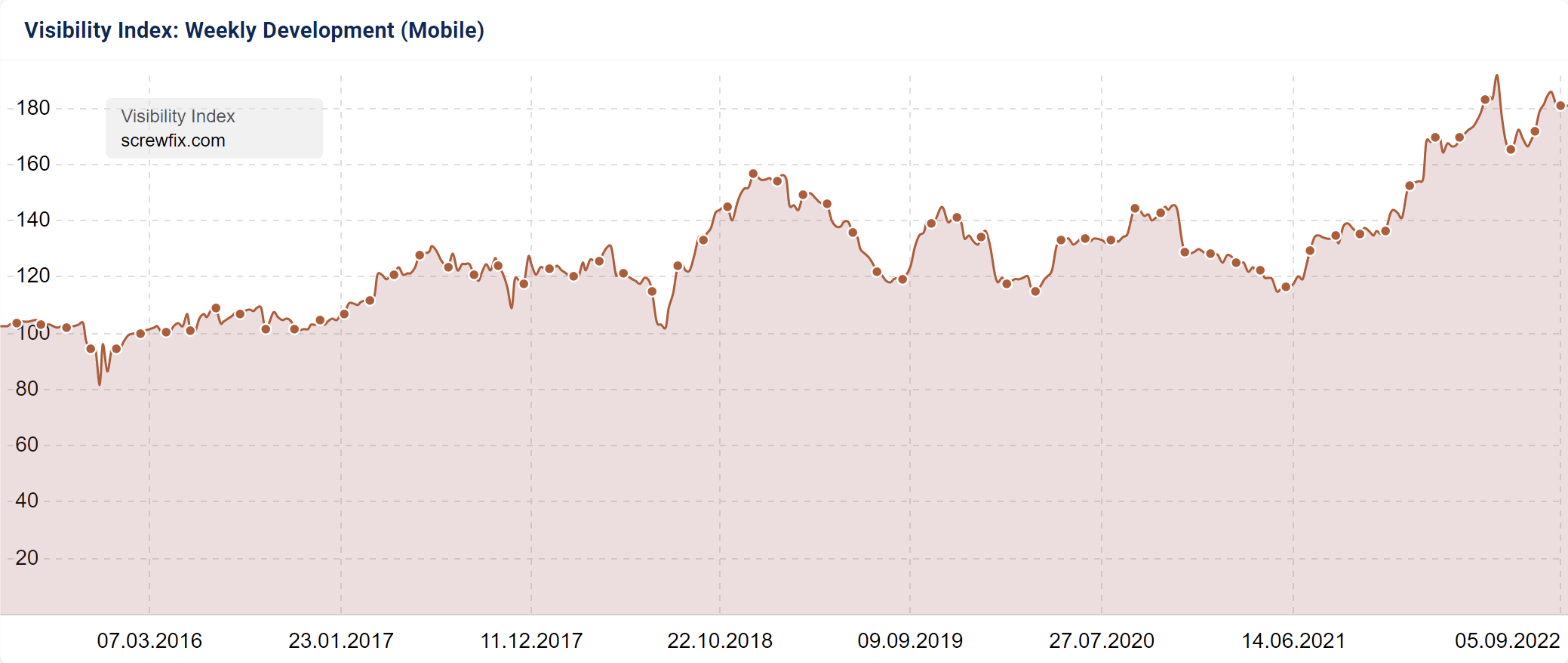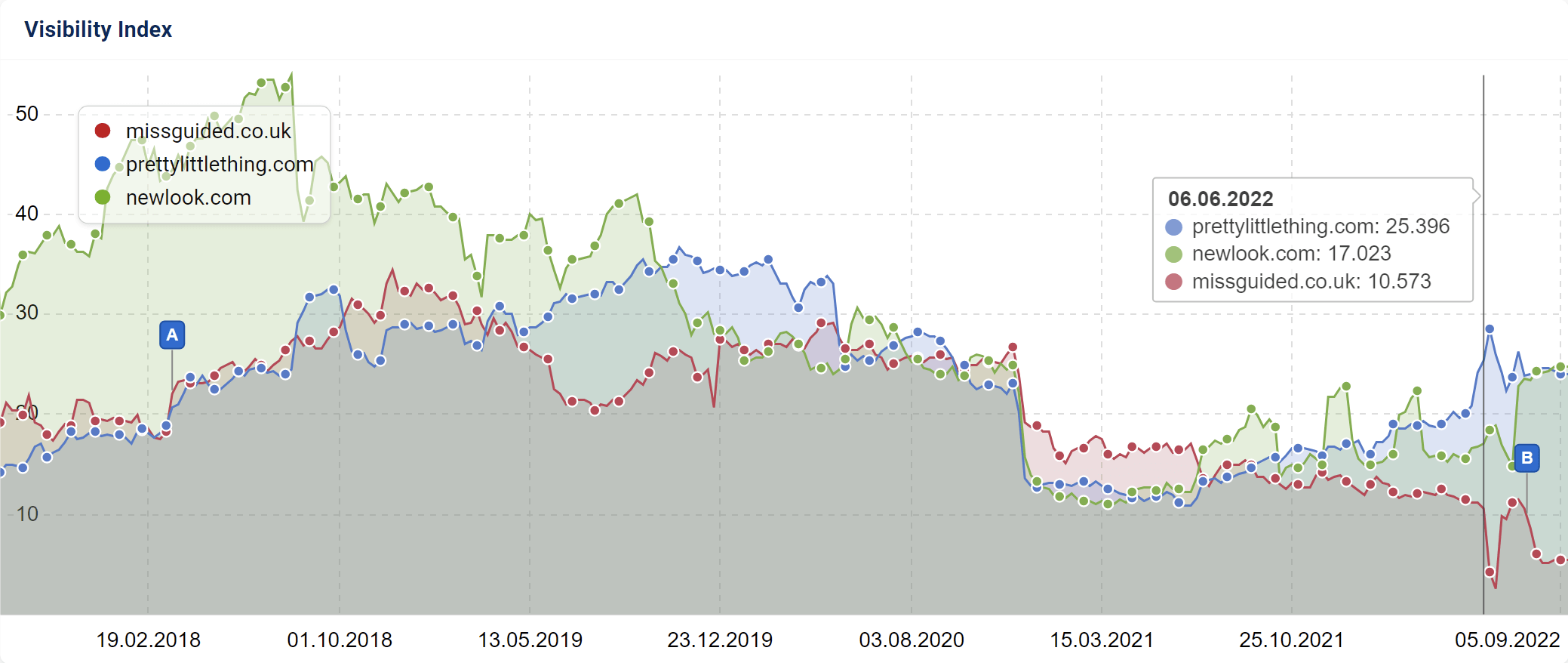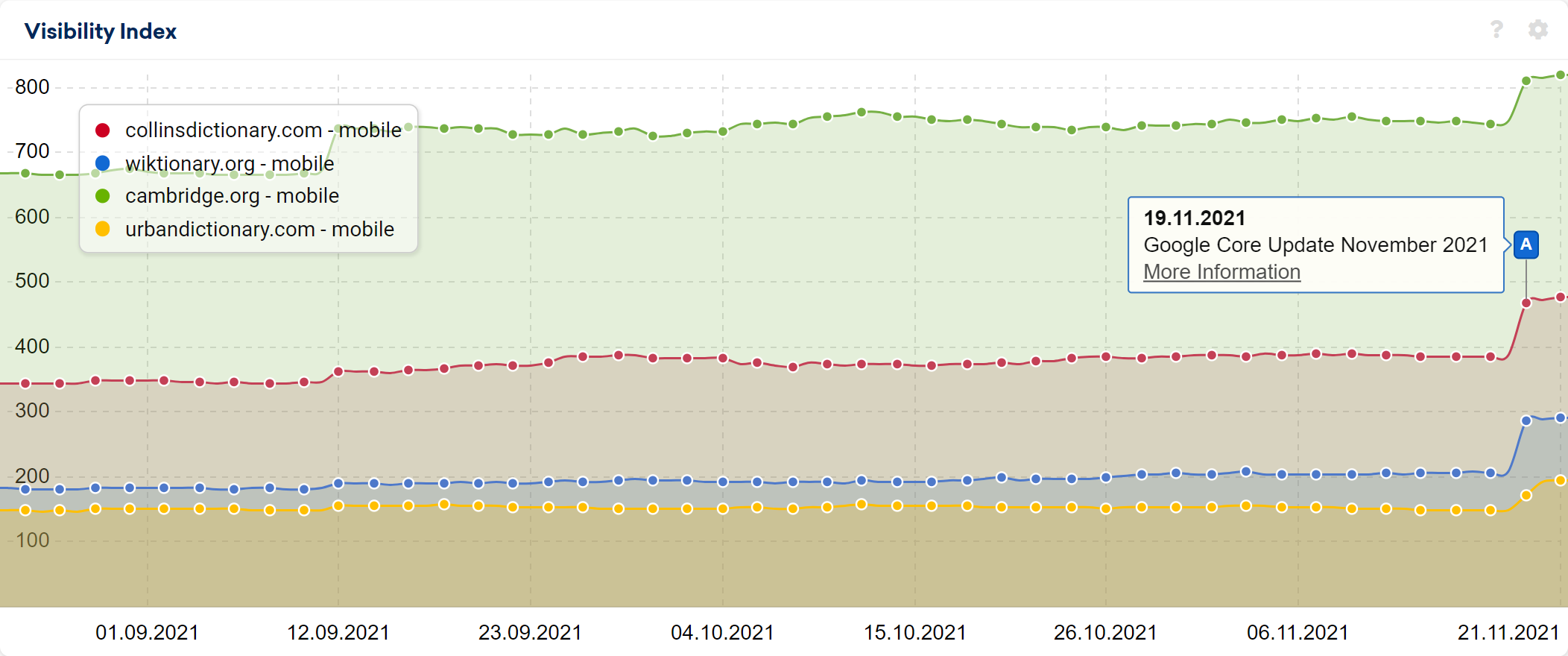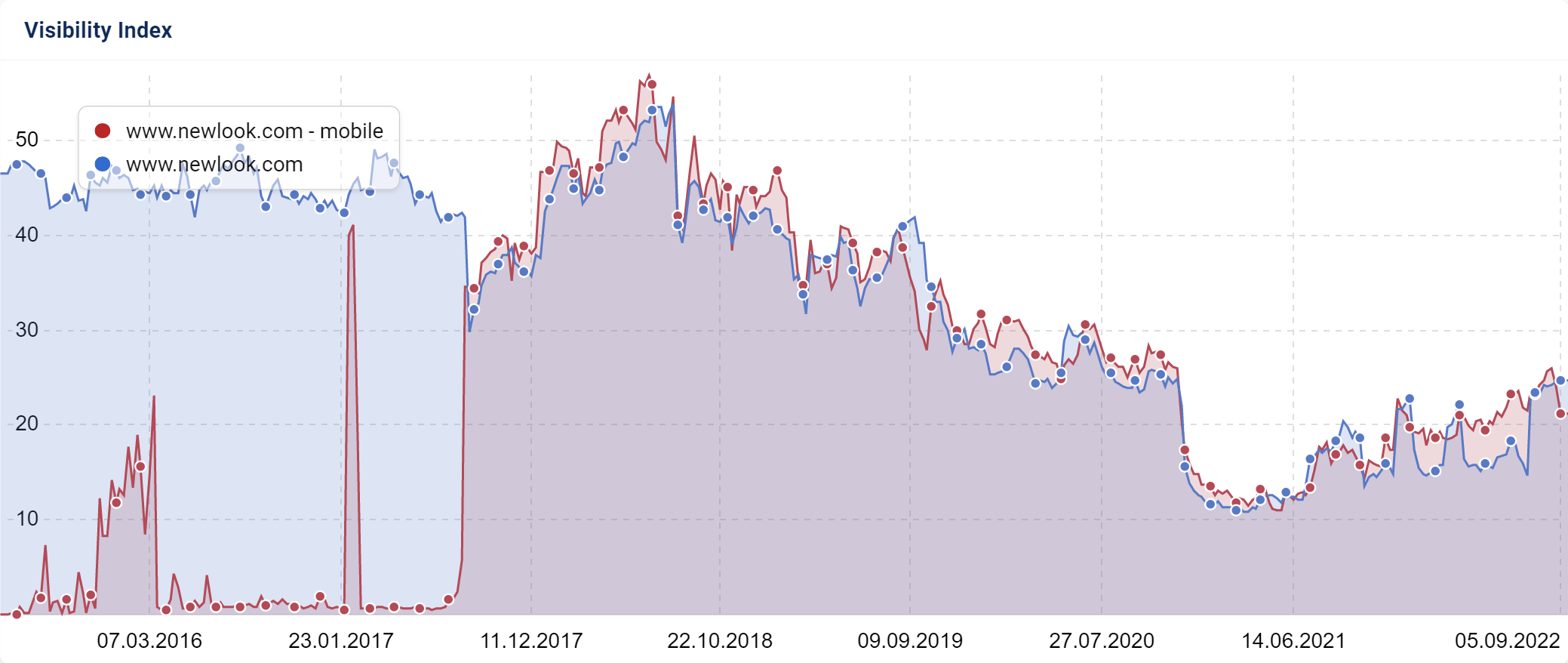The SISTRIX Visibility Index is a value for the visibility of a domain in Google’s search results. By using the Visibility Index, success in Google SERPs can be measured reliably and transparently.
- Strengths and limits
- Calculating the Visibility Index
- Countries supported
- Daily and weekly updates
- Mobile vs desktop rankings
- Frequently asked questions
- How can I improve my Visibility Index?
- What is a good Visibility Index value?
- Which search results are included in the Visibility Index?
- What are the differences to Google Search Console?
- Changelog
We invented the Visibility Index in 2008. Since then it has established itself as the gold standard for measuring SEO success. In this article you’ll find out more about the Visibility Index, how it is calculated, what you can achieve with it, and how it’s conceptually different from other marketing performance indicators.
With the Visibility Index you can understand how your domain has developed with Google. Regardless of external influences, you can see whether your SEO activities are successful, or are heading in the wrong direction. The effects of Google updates on your rankings are also shown very precisely in the Visibility Index.

The Visibility Index is also perfect for meaningful competitor analysis. With reliable and comparable data from 34 countries, you can see at-a-glance where your domain is positioned, compared to the real competitors. The market leaders in your segment provide you with a blueprint for future SEO success.

You can determine the current Visibility Index of any domain with our free Visibility Index query tool. You can get historical data, a precise breakdown into sub-domains, directories & URLs and more in the Toolbox. If you don’t have an account yet, you can test the Toolbox completely free of charge for 7 days.
Strengths and limits
The SISTRIX Visibility Index is conceptually different from web analysis values (and also the data that you’ll find in the Google Search Console.)
By actively measuring the rankings across a representative keyword set, the SISTRIX data is free from external influences such as seasonality, the weather, vacation times and other external factors and trends. This is the only way you can reliably recognise whether your SEO measures are working.
Top performance is impossible without an objective comparison with your competitors. The Visibility Index gives you this comparison. We show you, with a single value, how well you rank in comparison to your competitors. You can see at a glance whether you rank above average or badly. This benchmarking function is one of the core tasks of the Toolbox.
The Toolbox is delivered with an integral time machine, so to speak. It contains all relevant search results since 2008 so you don’t have to configure projects and wait for the results. We show you Visibility Index values for more than 100 million domains and 30 countries, at the push of a button. This allows you to understand historical developments retrospectively, and plan your future SEO success.
The Visibility Index is not designed to be as a traffic index. We measure SEO success and not visitors to your website. Although the number of SEO visitors correlates strongly with the Visibility Index in most cases, external influences, seasonal factors and other factors can lead to deviations.
Even if we cover most industries and topics for Google search well with 100 million daily data points, there may be very small niches and special topics whose search volume is too low to be sufficiently represented in the keyword set of the Visibility Index. In these cases, you can create your own project visibility index based on your keywords in the Optimizer. This is also suitable for countries that we do not yet support or local tracking down to the city level.
Calculating the Visibility Index
The SISTRIX Visibility Index is calculated in three steps. There have been no changes to the basic calculation since the introduction of the first Visibility Index in 2008, making all historical values comparable. The calculation process proceeds as follows:
- In the first step, we collect the search results for a million search queries (keywords). We have selected these keywords so that they form a representative cross-section of the search volume in the respective country. We regularly exchange some of these keywords to reflect changes in demand. For the Visibility Index, only the so-called organic Google results count in the search results, usually 100 results per keyword. In this way, 100 million data points (1,000,000 x 100) are determined as the basis for the Visibility Index.
- The second step of the calculation consists of weighting these data points according to the search volume of the keyword and the expected click probability on the measured, organic position. Position eight on a very high-traffic search term such as “nintendo switch” gives a higher value than position one on a low-traffic keyword such as “nintendo switch memory card recommendation”. Click probabilities also often differ in terms of the search intent of the keyword: while searchers with the “go to website intention” generally only get a click the first result, “know intention” results also get clicks on lower results more often.
- In the final, third step, the weighted values for all rankings of a domain are added up. The sum of all values gives the Visibility Index. In the Toolbox you can see the overall Visibility Index of a domain, but also partial values for individual sub-domains, directories and even URLs.
The Visibility Index is automatically determined for every domain that ranks for at least one of the one million keywords examined. 100,000 Visibility Index points are distributed across all rankings and domains found. The Toolbox contains visibility values for over 100 million domains.
Countries supported
Since the start of the visibility measurements for Germany in early 2008, new countries have been added continuously so that Visibility Index values are now available for over 35 countries. Your Toolbox account will gives you access to the Visibility Index values for all countries. There are no artificial restrictions to the amount of data that can be seen in the Toolbox. More details for countries are show below:
| Country | Google Domain | Language | Devices | Updates | Active since |
|---|---|---|---|---|---|
| Germany | google.de | German | Mobile & Desktop | Daily | 25.02.2008 |
| Great Britain | google.co.uk | English | Mobile & Desktop | Daily | 26.07.2010 |
| France | google.fr | French | Mobile & Desktop | Daily | 26.07.2010 |
| Italy | google.it | Italian | Mobile & Desktop | Daily | 26.07.2010 |
| Spain | google.es | Spanish | Mobile & Desktop | Daily | 26.07.2010 |
| USA | google.com | English | Mobile & Desktop | Daily | 31.01.2011 |
| Austria | google.at | German | Mobile & Desktop | Daily | 21.11.2011 |
| Switzerland | google.ch | German | Mobile & Desktop | Daily | 21.11.2011 |
| Netherlands | google.nl | Dutch | Mobile & Desktop | Daily | 18.05.2015 |
| Poland | google.pl | Polish | Mobile & Desktop | Daily | 15.06.2015 |
| Sweden | google.se | Swedish | Mobile & Desktop | Daily | 05.10.2015 |
| Brasil | google.com.br | Portuguese | Mobile & Desktop | Daily | 21.12.2015 |
| Turkey | google.com.tr | Turkish | Mobile & Desktop | Daily | 14.03.2016 |
| Belgium | google.be | Dutch | Mobile | Weekly | 01.10.2018 |
| Ireland | google.ie | English | Mobile | Weekly | 01.10.2018 |
| Portugal | google.pt | Portuguese | Mobile | Weekly | 01.10.2018 |
| Denmark | google.dk | Danish | Mobile | Weekly | 19.10.2018 |
| Norway | google.no | Norwegian | Mobile | Weekly | 19.10.2018 |
| Finland | google.fi | Finnish | Mobile | Weekly | 19.10.2018 |
| Greece | google.gr | Greek | Mobile | Weekly | 26.10.2018 |
| Hungary | google.hu | Hungarian | Mobile | Weekly | 26.10.2018 |
| Slovakia | google.sk | Slovak | Mobile | Weekly | 26.10.2018 |
| Czech Republic | google.cz | Czech | Mobile | Weekly | 26.10.2018 |
| Canada | google.ca | English | Mobile | Weekly | 04.01.2019 |
| Australia | google.com.au | English | Mobile | Weekly | 04.01.2019 |
| Mexico | google.com.mx | Spanish | Mobile | Weekly | 04.01.2019 |
| Russia | google.ru | Russian | Mobile | Weekly | 04.01.2019 |
| Japan | google.co.jp | Japanese | Mobile | Weekly | 06.01.2019 |
| India | google.in | English | Mobile | Weekly | 25.11.2019 |
| South Africa | google.co.za | English | Mobile | Weekly | 25.11.2019 |
| Romania | google.ro | Romanian | Mobile | Weekly | 13.09.2021 |
| Croatia | google.hr | Croatian | Mobile | Weekly | 13.09.2021 |
| Slovenia | google.si | Slovene | Mobile | Weekly | 13.09.2021 |
| Bulgaria | google.bg | Bulgarian | Mobile | Weekly | 13.09.2021 |
| Thailand | google.co.th | Thai | Mobile | Weekly | 13.09.2021 |
| Vietnam | google.com.vn | Vietnamese | Mobile | Weekly | 13.09.2021 |
| Indonesia | google.co.id | Indonesian | Mobile | Weekly | 13.09.2021 |
| Argentina | google.com.ar | Spanish | Mobile | Weekly | 25.10.2021 |
| Peru | google.com.pe | Spanish | Mobile | Weekly | 15.11.2021 |
| Colombia | google.com.co | Spanish | Mobile | Weekly | 25.10.2021 |
| Malta | google.com.mt | English | Mobile | Weekly | 02.10.2023 |
| Malaysia | google.com.my | Malay | Mobile | Weekly | 02.10.2023 |
| Philippines | google.com.ph | Filipino | Mobile | Weekly | 02.10.2023 |
| United Arab Emirates | google.ae | Arabic | Mobile | Weekly | 09.10.2023 |
| Chile | google.cl | Spanish | Mobile | Weekly | 09.10.2023 |
| Cyprus | google.com.cy | Greek | Mobile | Weekly | 09.10.2023 |
| Nigeria | google.ng | English | Mobile | Weekly | 09.10.2023 |
| New Zealand | google.co.nz | English | Mobile | Weekly | 09.10.2023 |
| Pakistan | google.com.pk | Urdu | Mobile | Weekly | 09.10.2023 |
| Singapore | google.com.sg | Malay | Mobile | Weekly | 09.10.2023 |
| Ukraine | google.ua | Ukrainian | Mobile | Weekly | 16.10.2023 |
| Venezuela | google.co.ve | Spanish | Mobile | Weekly | 16.10.2023 |
The search results are measured in one language for each country. In multilingual countries like Belgium or Canada, we chose the most widely used language. We add new countries if there is sufficient demand for the respective country from our customers. Please contact SISTRIX support if you are missing a country. We will not add the country directly, but we would be happy to include your request in our planning.
Daily and weekly updates
For the thirteen countries with mobile and desktop data, we have been calculating the Visibility Index daily since 2016. This allows you to make the right decisions, quickly, especially when it comes to Google updates, important relaunches or migrations. The daily data is usually available in the Toolbox from midnight and is displayed automatically.
Daily visibility data is available for 90 days after it is created. Monday’s data point is permanently archived in the Toolbox and is used for historical comparison over longer periods of time.

Originally, the visibility values were updated once a week: during the week, the search results were collected, followed by the processing and publication of the figures at the weekend. This continues to be the case for all pure mobile countries: the complete update of all SERPs during the week and the publication of the new data at the end of the weekend.
Mobile vs desktop rankings
Since Google announced, in 2015, that there may be differences in ranking between desktop and mobile use, the Toolbox has been offering both desktop and mobile data and, consequently, a mobile Visibility Index. In the account settings, you can determine whether the display of the desktop or the mobile is preferred in your Toolbox account.

Since significantly more mobile than desktop searches are now taking place in almost all countries, we collect only the mobile rankings for the countries added since 2018. There are no desktop rankings and therefore no desktop Visibility Index available for these countries.
Frequently asked questions
To increase the possibility to understand and use the Visibility Index in the best possible way we offer Toolbox Workshops in many cities around Europe. Every customer is invited to participate in one workshop per year, for free.
How can I improve my Visibility Index?
It’s not that an improvement in Visibility Index value leads to better rankings in Google, but that an improvement in rankings in Google leads to an improved Visibility Index value. Your goal is higher rankings for more keywords. The best way to do this is through competitor analysis. Based on the successful formats of your competitors, you develop your own SEO strategy. The implementation then leads to more and better rankings and thus to a measurably better Visibility Index.
What is a good Visibility Index value?
A good value for the Visibility Index can best be determined when it is compared with competitors – what value do your best competitors have and where do you stand in comparison? Use either the competitor function in the Toolbox or create your own keyword list and determine your competitors based on the domains found through your keywords.
Which search results are included in the Visibility Index?
The Visibility Index measures SEO success. We therefore use only Google’s organic search results for the calculation. Ads and other boxes from the search results are not included in the Visibility Index. If Google puts non-organic content in a position that displaces an organic search result, we assign these visibility points to an internal, virtual domain.
What are the differences to Google Search Console?
While the goal of the Visibility Index is to measure SEO success, the Google Search Console is an extension of web analysis data, such as Google Analytics, to web search. As a result, the numbers are driven by demand. There are also no competitive comparisons available. As a result, the Toolbox and the Google Search Console are two different tools with different goals and methodologies. You can find out more about the differences between the Toolbox and the Search Console in this detailed article on the subject.
Changelog
- December 2021: Visibility Index for Argentina, Peru & Columbia
- October 2021: Visibility Index for Thailand, Vietnam & Indonesia
- Sept 2021: Visibility data for Croatia, Bulgaria, Slovenia, Romania (link)
- November 2019: Visibility Index for India and South Africa. (Link)
- January 2019: Visibility Index for Canada, Australia, Mexico, Russia and Japan. (Link and link)
- October 2018: Visibility Index for Belgium, Ireland, Portugal, Denmark, Norway, Finland, Greece, Hungary, Slovakia and Czech Republic. (Link)
- September 2018: Daily Visibility Index for all countries. (Link)
- June 2018: Daily Visibility Index for UK. (Link)
- June 2016: New calculations for some Universal Search results. (Link)
- August 2015: Introduction of the Visibility Index for The Netherlands, Sweden, Poland, Brasil. (Link, link, link, link)
- July 2015: Mobile data and Visibility Index for all countries. (Link)
- April 2015: First mobile Visibility Index. (Link)
- Jan 2011: Visibility Index for the USA.
- July 2010: Introduction of the Visibility Index for Great Britain, Italy, France and Spain.